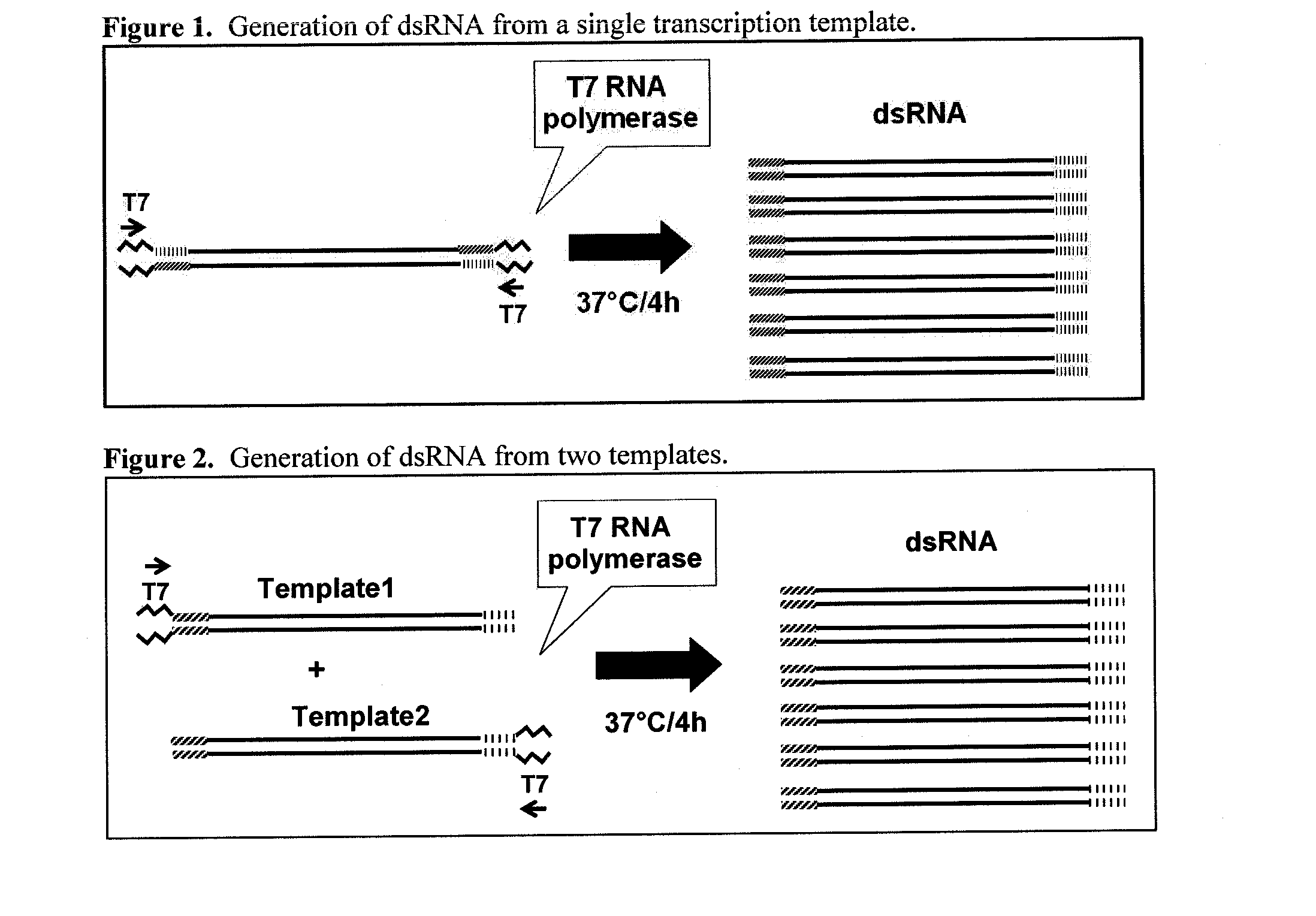Rnapii-140 nucleic acid molecules that confer resistance to coleopteran pests
a technology of nucleic acid molecules and coleopteran pests, applied in the field of rnapii-140 nucleic acid molecules that confer resistance to coleopteran pests, can solve problems such as reducing growth and/or reproduction, and achieve the effect of providing coleopteran pest resistan
- Summary
- Abstract
- Description
- Claims
- Application Information
AI Technical Summary
Benefits of technology
Problems solved by technology
Method used
Image
Examples
example 1
Identification of Candidate Target Genes
[0218]Multiple stages of WCR (Diabrotica virgifera virgifera LeConte) development were selected for pooled transcriptome analysis to provide candidate target gene sequences for control by RNAi transgenic plant insect resistance technology.
[0219]In one exemplification, total RNA was isolated from about 0.9 gm whole first-instar WCR larvae; (4 to 5 days post-hatch; held at 16° C.), and purified using the following phenol / TRI REAGENT®-based method (MOLECULAR RESEARCH CENTER, Cincinnati, Ohio):
[0220]Larvae were homogenized at room temperature in a 15 mL homogenizer with 10 mL of TRI REAGENT® until a homogenous suspension was obtained. Following 5 min. incubation at room temperature, the homogenate was dispensed into 1.5 mL microfuge tubes (1 mL per tube), 200 μL of chloroform was added, and the mixture was vigorously shaken for 15 seconds. After allowing the extraction to sit at room temperature for 10 min, the phases were separated by centrifugat...
example 2
Amplification of Target Genes to Produce dsRNA
[0237]Primers were designed to amplify portions of coding regions of each target gene by PCR. See Table 1. Where appropriate, a T7 phage promoter sequence (TTAATACGACTCACTATAGGGAGA; SEQ ID NO:6) was incorporated into the 5′ ends of the amplified sense or antisense strands. See Table 1. Total RNA was extracted from WCR, and first-strand cDNA was used as template for PCR reactions using opposing primers positioned to amplify all or part of the native target gene sequence. dsRNA was also amplified from a DNA clone comprising the coding region for a yellow fluorescent protein (YFP) (SEQ ID NO:7; Shagin et al. (2004) Mol. Biol. Evol. 21(5):841-50).
TABLE 1Primers and Primer Pairs used to amplify portions of coding regionsof exemplary rnapII-140 target gene and YFP negative control gene.SEQGene IDPrimer IDID NO:SequencePair 1rnapII reg1RNAPreg1-F1T7 8TTAATACGACTCACTATAGGGAGACCTACCCATTGGGAGAAAGACRNAPreg1-R1T7 9TTAATACGACTCACTATAGGGAGAAGCAGCTTTTT...
example 3
RNAi Constructs
[0238]Template Preparation by PCR and dsRNA Synthesis.
[0239]A strategy used to provide specific templates for rnapII-140 and YFP dsRNA production is shown in FIG. 1. Template DNAs intended for use in rnapII-140 dsRNA synthesis were prepared by PCR using the primer pairs in Table 1 and (as PCR template) first-strand cDNA prepared from total RNA isolated from WCR first-instar larvae (YFP was amplified from a DNA clone of a YFP coding region). For each selected rnapII-140 and YFP target gene region, PCR amplifications introduced a T7 promoter sequence at the 5′ ends of the amplified sense and antisense strands. The two PCR amplified fragments for each region of the target genes were then mixed in approximately equal amounts, and the mixture was used as transcription template for dsRNA production. See FIG. 1. The sequences of the dsRNA templates amplified with the particular primer pairs were: SEQ ID NO:3 (rnapII reg1), SEQ ID NO:4 (rnapII reg2), SEQ ID NO:5 (rnapII reg3)...
PUM
| Property | Measurement | Unit |
|---|---|---|
| Fraction | aaaaa | aaaaa |
| Fraction | aaaaa | aaaaa |
| Fraction | aaaaa | aaaaa |
Abstract
Description
Claims
Application Information
 Login to View More
Login to View More - R&D
- Intellectual Property
- Life Sciences
- Materials
- Tech Scout
- Unparalleled Data Quality
- Higher Quality Content
- 60% Fewer Hallucinations
Browse by: Latest US Patents, China's latest patents, Technical Efficacy Thesaurus, Application Domain, Technology Topic, Popular Technical Reports.
© 2025 PatSnap. All rights reserved.Legal|Privacy policy|Modern Slavery Act Transparency Statement|Sitemap|About US| Contact US: help@patsnap.com

